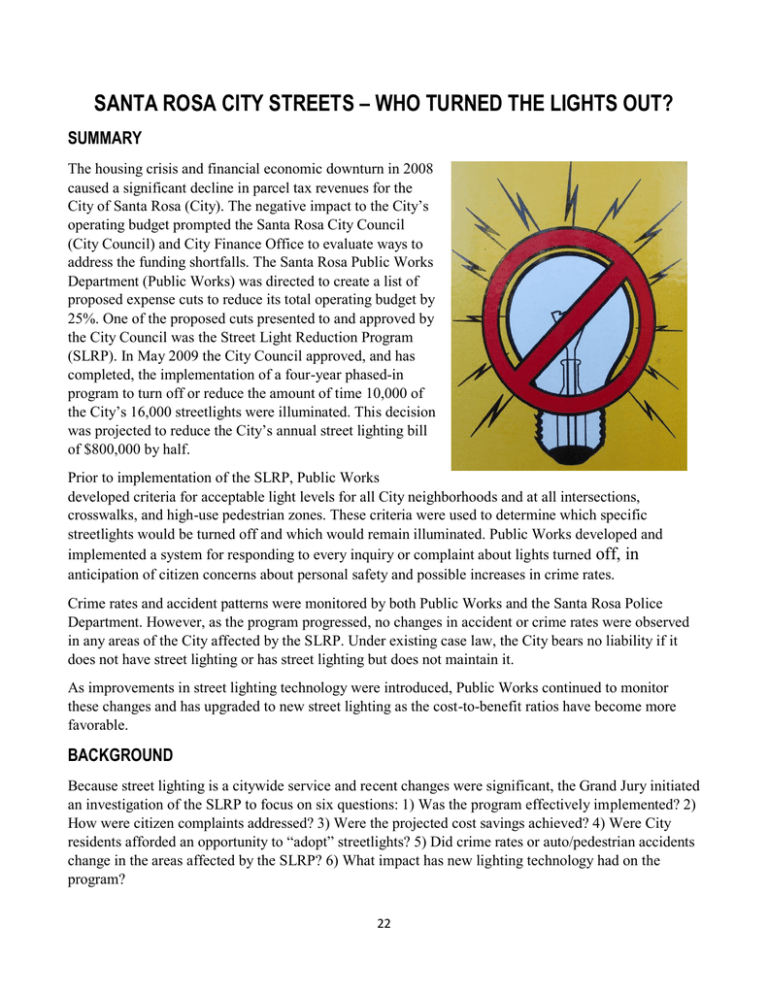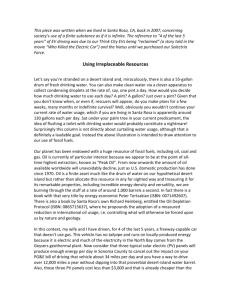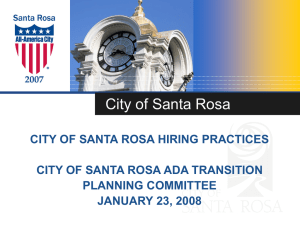SANTA ROSA CITY STREETS – WHO TURNED THE LIGHTS OUT?
advertisement

SANTA ROSA CITY STREETS – WHO TURNED THE LIGHTS OUT? SUMMARY The housing crisis and financial economic downturn in 2008 caused a significant decline in parcel tax revenues for the City of Santa Rosa (City). The negative impact to the City’s operating budget prompted the Santa Rosa City Council (City Council) and City Finance Office to evaluate ways to address the funding shortfalls. The Santa Rosa Public Works Department (Public Works) was directed to create a list of proposed expense cuts to reduce its total operating budget by 25%. One of the proposed cuts presented to and approved by the City Council was the Street Light Reduction Program (SLRP). In May 2009 the City Council approved, and has completed, the implementation of a four-year phased-in program to turn off or reduce the amount of time 10,000 of the City’s 16,000 streetlights were illuminated. This decision was projected to reduce the City’s annual street lighting bill of $800,000 by half. Prior to implementation of the SLRP, Public Works developed criteria for acceptable light levels for all City neighborhoods and at all intersections, crosswalks, and high-use pedestrian zones. These criteria were used to determine which specific streetlights would be turned off and which would remain illuminated. Public Works developed and implemented a system for responding to every inquiry or complaint about lights turned off, in anticipation of citizen concerns about personal safety and possible increases in crime rates. Crime rates and accident patterns were monitored by both Public Works and the Santa Rosa Police Department. However, as the program progressed, no changes in accident or crime rates were observed in any areas of the City affected by the SLRP. Under existing case law, the City bears no liability if it does not have street lighting or has street lighting but does not maintain it. As improvements in street lighting technology were introduced, Public Works continued to monitor these changes and has upgraded to new street lighting as the cost-to-benefit ratios have become more favorable. BACKGROUND Because street lighting is a citywide service and recent changes were significant, the Grand Jury initiated an investigation of the SLRP to focus on six questions: 1) Was the program effectively implemented? 2) How were citizen complaints addressed? 3) Were the projected cost savings achieved? 4) Were City residents afforded an opportunity to “adopt” streetlights? 5) Did crime rates or auto/pedestrian accidents change in the areas affected by the SLRP? 6) What impact has new lighting technology had on the program? 22 APPROACH The Grand Jury interviewed personnel at Public Works, Santa Rosa Finance Department, Santa Rosa Risk Manager’s office, Santa Rosa City Attorney’s office, Santa Rosa Police Department, Rohnert Park Public Works Department, the Santa Rosa Bicycle Coalition, and a Santa Rosa citizen. The Grand Jury also reviewed newspaper articles, City Council meeting minutes, and documents provided by interviewees and independent sources. DISCUSSION Public Works used the residential area of McDonald Avenue in the City as a model for determining the appropriate distance between streetlights that were to remain illuminated under the SLRP. In this area, streetlights are spaced approximately 300 feet apart. This was used as a standard for determining which streetlights would be left on, as there seemed to be adequate light to maintain pedestrian and traffic safety. It was also determined that for safety reasons lights would remain on at signalized intersections, at mid-block crosswalks, within high-use pedestrian zones, at un-signalized intersections if a traffic signal previously existed, and at selected locations where there had been a documented history of traffic safety issues. Information about the SLRP was communicated to citizens through press releases, a Public Works’ website announcement, and placards affixed to affected lampposts. As the program was implemented, citizens were directed to call a Public Works contact number or send an email to register concerns about streetlights that had been turned off. When a request or complaint is received, Public Works’ front desk staff checks to determine if the SLRP had designated for the light to be on or off. If the light was designated to be on, a “trouble ticket” is sent to the Maintenance Department for action. If the SLRP had designated that the light was to be turned off, the complaint is forwarded to the Public Works Director or the Deputy Director of Field Services who conducts a field inspection at night to evaluate the request or complaint. The inspection takes into consideration environmental factors such as distance between active lights, foot and auto traffic, potential obstructions such as trees, time of sunrise and sunset, moon cycles, and daylight savings time. A decision is made to re-light the streetlight or to keep it off, and the requestor is informed of the decision. The City has approximately 16,000 streetlights. After full implementation of the SLRP about 40% of the streetlights remain fully on, 20% are on timers, and 40% are turned off. Public Works estimated an annual energy cost savings of $400,000 would be phased in by the end of year 2012. The City Finance Department forecasted that 80% of the target cuts would be achieved totaling $320,000 per year at the end of implementation of the SLRP. There is currently an annual budget savings of approximately $321,000. An “Adopt a Streetlight Program” was tested by Public Works. Under the terms of this program, a citizen could request that individual streetlights be turned back on at a cost to the participant of $150 annually per streetlight. The program was terminated due to very low resident participation and challenges in administrating the program. The Santa Rosa Police Department and Public Works observed no changes in City crime rates or accidents as a direct result of the implementation of the SLRP. 23 Public Works is reviewing new lighting technology and monitors the continuing reduction of costs to purchase and operate various lamps to determine the appropriate timing of future streetlight upgrades. In 2010, the City received an American Recovery and Reinvestment Act grant of approximately $250,000 for streetlight upgrades to reduce greenhouse gasses. Part of this grant money was used to buy programmable photocells. These photocells permitted streetlights that were energized for 11 hours to be re-programmed to run for 5½ hours. Another part of this money was used to replace 700 high-pressure sodium lamps with induction lighting. Of the City’s streetlights, 95% are high-pressure sodium lamps which have a five-year life expectancy. Induction streetlights cost $290 per light with a life expectancy of 20 years. LED streetlights cost $320 per light, with a 15-year life expectancy. While LED units are currently the most expensive form of streetlight units to purchase, they draw the least amount of power and produce the smallest amount of greenhouse gasses compared to other existing streetlight types. For example, a 100 watt high-pressure sodium light can be replaced with a 40 watt LED to provide the same light. Public Works continues to review these new lighting technologies as costs drop. The goal is to determine how and when to integrate modern technology into the streetlight system. FINDINGS F1. Under challenging financial conditions, Public Works carefully developed, effectively implemented, and thoroughly tracked a significant change to the City’s street lighting program. F2. Public Works established a transparent, responsive, and efficient process for residents to present requests and complaints concerning streetlights that have been adjusted as part of the SLRP. F3. The savings generated by the SLRP are within the budgeted parameters. F4. After an appropriate test of an “Adopt a Streetlight Program,” Public Works terminated the program because of low resident participation and because there were not enough direct savings to offset the costs and challenges of administering it. F5. No definitive data suggest auto/pedestrian accidents and/or crime rates increased in the absence of street lighting in those areas affected by the SLRP. F6. Public Works has demonstrated that it is proactively monitoring and assessing new streetlight technologies with a goal of increasing energy cost savings and reducing greenhouse gasses and has made effective use of available grants to test and install newer technology lamps. RECOMMENDATIONS The Grand Jury recommends that the Santa Rosa Public Works Department: R1. Continue to monitor improvements in street lighting technology. R2. Periodically brief the Santa Rosa City Council and interested citizens on its plans for implementing new programs that will continue to control lighting costs, reduce greenhouse gasses, and provide safe and consistent light levels on City streets. 24 REQUIRED RESPONSES Pursuant to Penal Code Section 933.05, the Grand Jury requires responses as follows: R1, R2 - City of Santa Rosa Director of Public Works DISCLAIMER This report is issued by the Grand Jury with the exception of one member of the jury who recused him/herself. This juror was excluded from all parts of the investigation, including interviews, deliberations, and the writing and acceptance of the report. BIBLIOGRAPHY PG&E Rate Schedules City of Santa Rosa General Ledger Budgets Siminovich, Michael. “UC Davis Professor Calls for a Statewide ‘Time Out’ on Further Public Purchases of LED Street Lights.” U.S. Department of Justice, Street Lighting Projects National Evaluation Program Phase I Report Plattner v. City of Riverside, 69 Cal.App.4th, 1441 (1999) Mixon v. State, 207 Cal.App.4th, 124 (2012) Citizen complaints and subsequent resolutions by Santa Rosa Public Works Department Reports issued by the Civil Grand Jury do not identify individuals interviewed. Penal Code Section 929 requires that reports of the Grand Jury not contain the name of any person or facts leading to the identity of any person who provides information to the Civil Grand Jury. 25



